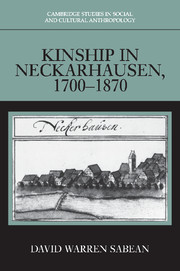Book contents
- Frontmatter
- Contents
- List of tables
- Abbreviations
- Abbreviations of sources
- On reading kinship diagrams
- Glossary
- Preface
- Introduction
- Cohort I (1700–1709)
- Cohort II (1740–1749)
- Cohort III (1780–1789)
- 11 Consanguinity as a principle of alliance
- 12 The formation of an alliance system
- 13 Ritual kinship and alternative alliance
- 14 Naming and patrilineal alliance
- Cohort IV (1820–1829)
- Cohort V (1860–1869)
- Conclusion
- Appendix
- Bibliography
- General index
- Index of villagers
14 - Naming and patrilineal alliance
Published online by Cambridge University Press: 04 August 2010
- Frontmatter
- Contents
- List of tables
- Abbreviations
- Abbreviations of sources
- On reading kinship diagrams
- Glossary
- Preface
- Introduction
- Cohort I (1700–1709)
- Cohort II (1740–1749)
- Cohort III (1780–1789)
- 11 Consanguinity as a principle of alliance
- 12 The formation of an alliance system
- 13 Ritual kinship and alternative alliance
- 14 Naming and patrilineal alliance
- Cohort IV (1820–1829)
- Cohort V (1860–1869)
- Conclusion
- Appendix
- Bibliography
- General index
- Index of villagers
Summary
Names can be considered from several perspectives. Lévi-Strauss has discussed them in terms of the possibilities they offer for classifying either or both the name giver and the name receiver. This chapter demonstrates that naming children during the late eighteenth century was an exercise that frequently marked out the patrilineal group to which a newborn child belonged, although the purpose was probably to underline the connections of the parents to particular people more than to position the child in a patrilineage. Each newborn was furnished with a surname from the patriline and a single or double Christian name (Johannes, Johann Georg), which offered the possibility of establishing specific ties between parents and particular people. Just as in the early part of the century, names were never used systematically to honor or recall individuals from previous generations.
At the birth of each child the parents had a chance to draw attention to a particular relationship. The field of meaningful relationships, as noted earlier, was always already marked out by the exchange of marriage partners and godparents. Although it was possible to strike out in a new direction or even to ignore relations out of lukewarmness or spite, names were usually in fact exchanged within preestablished networks. Chapters 12 and 13 have shown that Bauern families and others with considerable amounts of property established alliances over several generations that created overlapping ties of consanguinity, affinity, and ritual kinship.
- Type
- Chapter
- Information
- Kinship in Neckarhausen, 1700–1870 , pp. 256 - 260Publisher: Cambridge University PressPrint publication year: 1997



